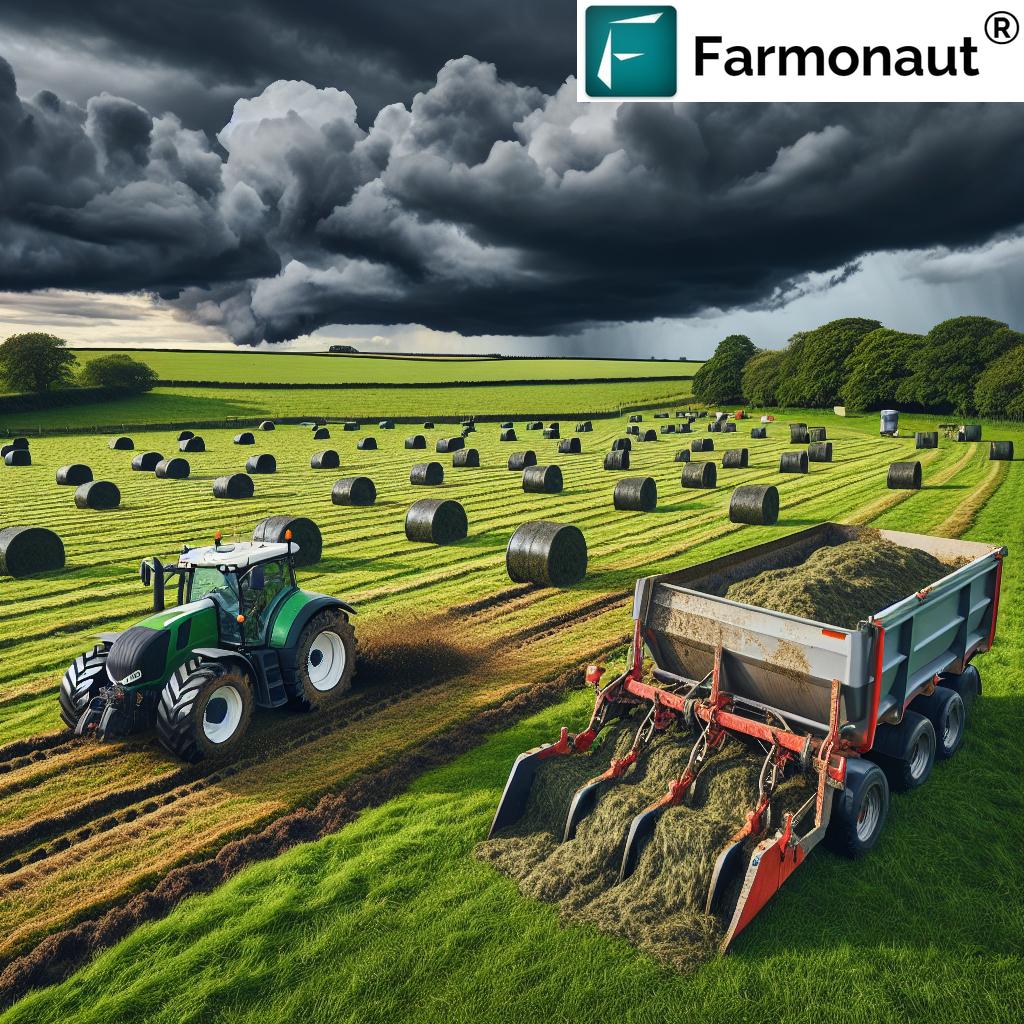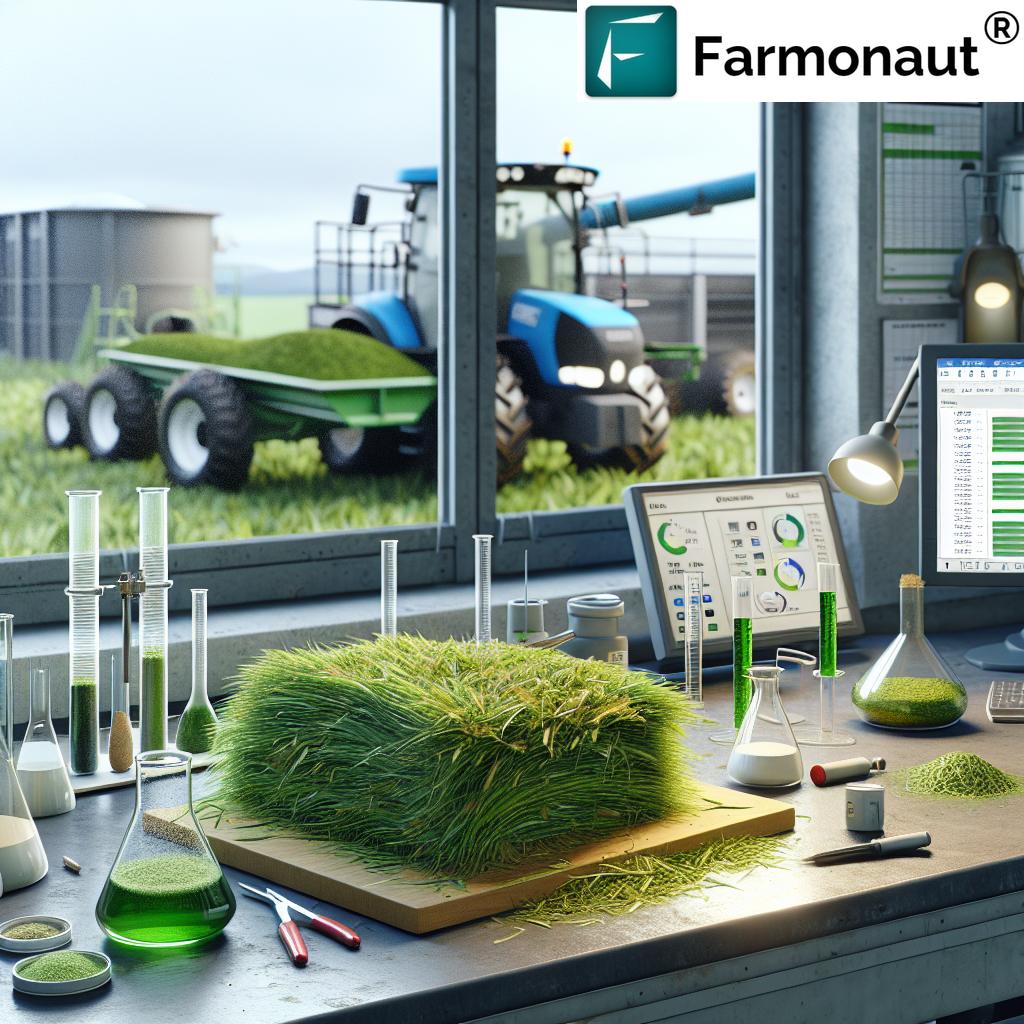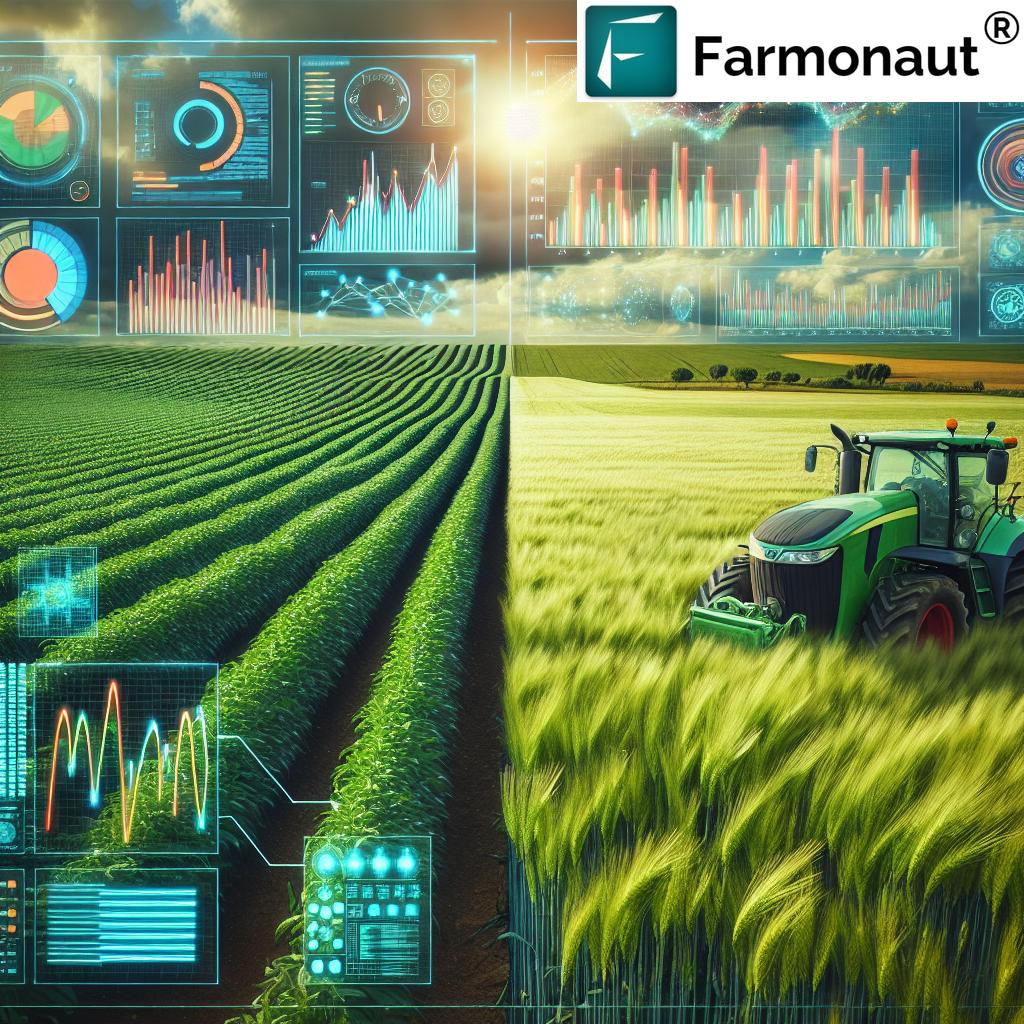Mastering Silage Production in England: Expert Tips for Farmers After a Wet Winter
“Wet winter conditions can reduce silage dry matter content by up to 30%, significantly impacting feed quality.”
As we navigate the challenges of silage production in England following a particularly wet winter, it’s crucial for farmers to adapt their strategies to ensure optimal yield and quality. In this comprehensive guide, we’ll explore expert techniques for managing wet field conditions, improving silage quality, and maintaining sustainable farming practices. From soil contamination prevention to the intricacies of the silage fermentation process, we’ll cover everything you need to know to master silage production in challenging circumstances.
Understanding the Impact of Wet Winters on Silage Production
Wet winters pose significant challenges for farmers across England and Wales, particularly when it comes to silage production. Excess moisture in the soil can lead to various issues that affect both the quantity and quality of silage. Let’s delve into the key concerns:
- Soil Compaction: Waterlogged fields are more susceptible to compaction when heavy machinery is used, potentially damaging soil structure and reducing grass growth.
- Delayed Field Operations: Wet conditions can postpone crucial activities like slurry application and harvesting, affecting the overall silage production timeline.
- Increased Soil Contamination Risk: Muddy conditions increase the likelihood of soil being incorporated into the silage, which can negatively impact fermentation and nutritional value.
- Reduced Dry Matter (DM) Content: Excess moisture in the crop can dilute the dry matter content, potentially leading to poor fermentation and reduced feed value.
Understanding these challenges is the first step in developing effective strategies to mitigate their impact on silage production.
[Youtube Video: Farmonaut’s Advanced Agri Solutions: Precision Crop Area Estimation – Egypt Case Study](https://youtube.com/watch?v=Fn5gY7QtFjo)
Optimal Slurry Application Timing for Wet Field Conditions
Proper timing of slurry applications is crucial for maximizing nutrient uptake and minimizing soil damage. Here are some expert tips for managing slurry applications after a wet winter:
- Wait for Appropriate Soil Conditions: Assess field conditions regularly and wait until the soil can support machinery without causing significant compaction.
- Use Weather Forecasts: Utilize reliable weather forecasting services to plan applications during dry spells. Farmonaut’s satellite-based monitoring system can provide valuable insights into field conditions and weather patterns.
- Consider Low Emission Spreading Techniques: Trailing shoe or injection methods can help reduce ammonia losses and improve nutrient utilization, especially in wet conditions.
- Monitor Nutrient Levels: Regular soil testing can help determine the optimal timing and quantity of slurry applications, ensuring efficient use of nutrients.
By carefully timing slurry applications, farmers can improve nutrient efficiency and reduce the risk of runoff, contributing to both better silage quality and environmental sustainability.
Effective Grass Harvesting Techniques for Challenging Conditions
Harvesting grass for silage in wet conditions requires careful planning and execution. Here are some strategies to optimize your harvest:
- Adjust Cutting Height: Raising the cutting height can help reduce soil contamination and improve regrowth potential.
- Optimize Wilting Time: If weather permits, allow for adequate wilting time to increase dry matter content. However, be prepared to harvest quickly if rain is forecasted.
- Use Mower Conditioners: These tools can help speed up the wilting process by crimping the grass stems, allowing for faster moisture loss.
- Consider Tedding: In drier spells, tedding can help speed up the wilting process, but avoid this practice if the ground is too wet to prevent soil contamination.
Implementing these techniques can help maintain silage quality even when faced with challenging harvesting conditions.

Preventing Soil Contamination in Silage
Soil contamination is a significant risk in wet conditions and can severely impact silage quality. Here are some strategies to minimize this risk:
- Proper Machinery Alignment: Ensure all harvesting equipment is correctly set up and aligned to minimize soil disturbance.
- Use of Flotation Tires: Wide, low-pressure tires can help distribute the weight of machinery more evenly, reducing soil compaction and rutting.
- Avoid Overloading Trailers: Heavier loads increase the risk of soil compaction and contamination. Consider using smaller loads when conditions are particularly wet.
- Implement Strip Grazing: This technique can help maintain grass cover and reduce poaching, minimizing soil exposure during harvest.
By implementing these practices, farmers can significantly reduce the risk of soil contamination in their silage, ensuring better fermentation and nutritional quality.
Enhancing Silage Quality with Additives
“Proper use of silage additives can increase lactic acid bacteria populations by 100-fold, enhancing preservation efficiency.”
Silage additives can play a crucial role in improving fermentation and preserving nutritional value, especially when dealing with challenging conditions. Here’s what you need to know:
- Types of Additives: Common additives include bacterial inoculants, enzymes, and acids. Each type has specific benefits depending on crop conditions and silage goals.
- Bacterial Inoculants: These additives introduce beneficial lactic acid bacteria to accelerate fermentation and improve stability.
- Enzyme Additives: Enzymes can help break down complex carbohydrates, making them more available for fermentation.
- Acid Additives: These can be particularly useful for very wet crops, helping to quickly lower pH and inhibit undesirable microorganisms.
When selecting an additive, consider factors such as crop dry matter content, sugar levels, and specific challenges posed by wet conditions. Consult with a silage specialist to determine the most appropriate additive for your situation.
[Youtube Video: Unlocking Soil Organic Carbon: The Secret to Sustainable Farming with Farmonaut](https://youtube.com/watch?v=GEWF0ite050)
The Role of Lactic Acid Bacteria in Silage Preservation
Understanding the importance of lactic acid bacteria (LAB) in the silage fermentation process is key to producing high-quality silage. Here’s why LAB are crucial:
- Rapid pH Reduction: LAB produce lactic acid, which quickly lowers the pH of the silage, inhibiting the growth of harmful bacteria.
- Preservation of Nutrients: The rapid acidification helps preserve valuable nutrients, maintaining the silage’s feed value.
- Improved Stability: A well-fermented silage with a predominance of LAB is more stable during storage and feed-out.
To promote the growth of beneficial LAB, consider the following strategies:
- Ensure adequate sugar content in the crop at harvest
- Achieve proper compaction to create anaerobic conditions
- Use bacterial inoculants when natural LAB populations may be low
- Maintain clean harvesting and storage practices to minimize contamination
By fostering an environment conducive to LAB growth, farmers can significantly improve silage quality and preservation.
Managing Wet Field Conditions for Optimal Silage Production
Dealing with wet field conditions requires a multifaceted approach to ensure successful silage production. Here are some key strategies:
- Improved Drainage Systems: Invest in field drainage to help remove excess water more quickly. This can include both surface and subsurface drainage solutions.
- Crop Selection: Consider planting grass varieties or other crops that are more tolerant of wet conditions.
- Timing of Field Operations: Be flexible with your farming calendar. Use weather forecasts and soil moisture sensors to identify optimal windows for field operations.
- Reduced Tillage Practices: Minimize soil disturbance to help maintain soil structure and improve water infiltration.
Implementing these practices can help mitigate the challenges posed by wet field conditions, allowing for more consistent silage production even in difficult years.

Optimizing Dry Matter and Energy Content in Silage
Maintaining optimal dry matter (DM) and energy content in silage is crucial for livestock nutrition. Here are some tips to achieve this:
- Monitor Crop Maturity: Harvest at the optimal stage of maturity to balance yield and nutritional quality.
- Implement Proper Wilting Techniques: Aim for a target DM content of 30-35% for grass silage. Use mower conditioners and tedders when appropriate to speed up the wilting process.
- Avoid Over-wilting: While increasing DM is important, over-wilting can lead to leaf shatter and nutrient loss, especially in legume crops.
- Use of Additives: In challenging conditions, consider using additives that can help preserve energy content and improve fermentation.
By focusing on these aspects, farmers can produce silage with higher nutritional value, benefiting livestock health and productivity.
Sustainable Farming Practices for Silage Production
Incorporating sustainable practices into silage production not only benefits the environment but can also improve long-term farm productivity. Consider the following approaches:
- Crop Rotation: Implement diverse crop rotations to improve soil health and reduce pest and disease pressures.
- Cover Cropping: Use cover crops between main silage crops to protect soil, improve structure, and add organic matter.
- Precision Agriculture: Utilize technologies like Farmonaut’s satellite-based monitoring to optimize resource use and reduce waste.
- Carbon Footprint Reduction: Implement practices that minimize greenhouse gas emissions, such as optimizing fertilizer use and improving energy efficiency.
By adopting these sustainable practices, farmers can enhance soil health, reduce environmental impact, and improve the resilience of their silage production systems.
[Youtube Video: Farmonaut’s Remarkable Half-Year Achievements 2023!](https://youtube.com/watch?v=12A8B_7uC-A)
Leveraging Technology for Improved Silage Management
Modern technology offers numerous tools to enhance silage production efficiency and quality. Here’s how farmers can leverage these advancements:
- Satellite-Based Monitoring: Utilize services like Farmonaut’s satellite-based crop monitoring to track field conditions and crop health in real-time.
- Precision Application Systems: Use GPS-guided equipment for more accurate slurry and fertilizer applications, reducing waste and improving nutrient management.
- Automated Weather Stations: Install on-farm weather stations to gather localized data for more informed decision-making.
- Silage Analysis Tools: Employ near-infrared (NIR) technology for rapid and accurate silage quality assessment.
By integrating these technologies into their operations, farmers can make more informed decisions, optimize resource use, and improve overall silage quality.
Silage Production Strategies Comparison
| Strategy | Soil Contamination Risk | Silage Quality Impact | Implementation Difficulty | Cost Effectiveness |
|---|---|---|---|---|
| Optimal Slurry Application Timing | Low | High | Medium | High |
| Enhanced Grass Harvesting Techniques | Low | High | Medium | Medium |
| Proper Machinery Alignment | Low | Medium | Low | High |
| Use of Silage Additives | N/A | High | Low | Medium |
| Lactic Acid Bacteria Management | N/A | High | Medium | High |
This table provides a quick comparison of various silage production strategies, helping farmers choose the most appropriate techniques for their specific situations.
Farmonaut’s Role in Precision Agriculture for Silage Production
Farmonaut’s advanced agricultural solutions can significantly contribute to improving silage production processes. Here’s how our technology can assist farmers:
- Real-time Crop Monitoring: Our satellite-based crop health monitoring provides valuable insights into vegetation health (NDVI) and soil moisture levels, helping farmers make informed decisions about irrigation and harvesting timing.
- Weather Forecasting: Access accurate, localized weather forecasts to plan field operations more effectively.
- Field Management Tools: Use our platform to track and manage different fields, ensuring optimal crop rotation and resource allocation for silage production.
- Data-Driven Insights: Leverage our AI-powered advisory system to receive personalized recommendations for crop management and silage production strategies.
To explore how Farmonaut can enhance your silage production processes, visit our web application or download our mobile apps:
For developers interested in integrating our satellite and weather data into their own systems, check out our API and API Developer Docs.
[Youtube Video: Farmonaut Web app | Satellite Based Crop monitoring](https://youtube.com/watch?v=tD7cC-dI-Yc)
Conclusion: Mastering Silage Production in Challenging Conditions
Producing high-quality silage after a wet winter in England requires a combination of traditional farming wisdom and modern technological solutions. By implementing the strategies outlined in this guide, farmers can mitigate the challenges posed by wet field conditions, improve silage quality, and maintain sustainable farming practices.
Key takeaways include:
- Carefully timing slurry applications and field operations to minimize soil damage
- Employing effective grass harvesting techniques to optimize dry matter content
- Using silage additives and managing lactic acid bacteria to enhance fermentation
- Leveraging technology like Farmonaut’s satellite-based monitoring for precision agriculture
- Adopting sustainable farming practices to improve long-term productivity and environmental stewardship
By mastering these aspects of silage production, farmers can ensure high-quality feed for their livestock while adapting to the challenges of changing weather patterns. Remember, successful silage production is not just about overcoming immediate challenges but also about building resilient and sustainable farming systems for the future.
FAQ Section
Q: How does wet weather impact silage quality?
A: Wet weather can lead to increased soil contamination, reduced dry matter content, and challenges in achieving proper fermentation, all of which can negatively impact silage quality.
Q: What is the optimal dry matter content for grass silage?
A: The optimal dry matter content for grass silage is typically between 30-35%.
Q: How can I reduce soil contamination in my silage?
A: You can reduce soil contamination by adjusting cutting height, using proper machinery alignment, implementing strip grazing, and avoiding overloading trailers during harvest.
Q: Are silage additives necessary in wet conditions?
A: While not always necessary, silage additives can be particularly beneficial in wet conditions to improve fermentation and preserve nutritional value.
Q: How can technology help in silage production?
A: Technology like Farmonaut’s satellite-based monitoring can help by providing real-time data on crop health, weather conditions, and soil moisture, enabling more informed decision-making throughout the silage production process.















